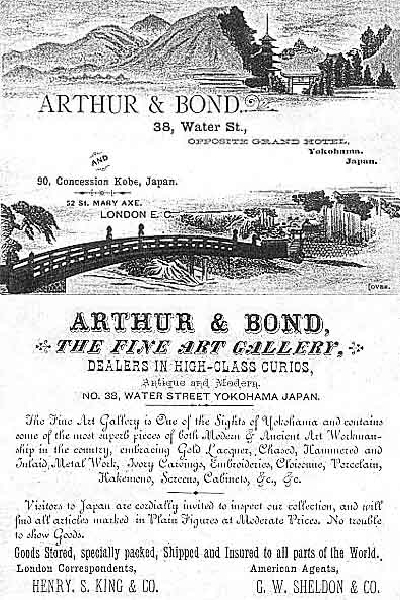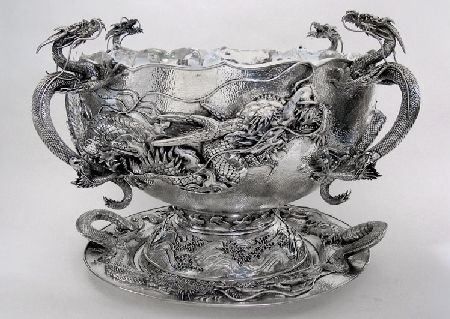Arthur & Bond
 Business Card of Arthur & BondArthur & Bond, the fine art gallery, dealers in high-class curios, antiques and modern, was located at No. 38 Water Street, Yokohama, Japan. They had two branches, one located at 90 Concession, Kobe, Japan, and another located at 52 St. Mary Axe, London E.C.. They also had London Correspondents, Henry. S. King & Co. and American Agent, G. W. Sheldon & Co..
Business Card of Arthur & BondArthur & Bond, the fine art gallery, dealers in high-class curios, antiques and modern, was located at No. 38 Water Street, Yokohama, Japan. They had two branches, one located at 90 Concession, Kobe, Japan, and another located at 52 St. Mary Axe, London E.C.. They also had London Correspondents, Henry. S. King & Co. and American Agent, G. W. Sheldon & Co..
Their business card describes;
The Fine Art Gallery is one of the Sights of Yokohama and contains some of the most superb pieces of both modern & Ancient Art Workmanship in the country, embracing Gold Lacquer, Chased, hammered and inlaid Metal Works, Ivory Carvings, Embroideries, Cloisonne, Porcelain, Kakemono, Screens, Cabinets, so, so.
Visitors to Japan are cordially invited to inspect our collection, and will find all articles marked in Plain Figures at Moderate Prices. No troouble to show Goods.
They catered mainly to English expatriates and foreign travelers. They appear to have been retailers and manufacturers of a wide variety of goods, including Gold Lacquer, Chased, hammered and inlaid Metal Works, Ivory Carvings, Embroideries, Cloisonne, Porcelain, Kakemono, Screens, Cabinets.
They were a retailer but also an active manufacturer to employ local silversmiths. We can see some of their surviving products, like various pieces of silver including a Swiss watch with a Japanese silver case with their name on it. Among them the most famous and monumental product is the Liscum Bowl which was made by Japanese silversmiths employed by them in 1902.
The Liscum Bowl
 The Liscum Bowl made by Japanese silversmiths employed by Arthur & Bond, 1902. Now located in Korea.The Liscum Bowl is one of the largest sterling silver objects ever made: 90 pounds, 40” across, 24” high, with a capacity of 14 gallons. It was created in 1900 by Japanese silversmiths employed by Arthur & Bond from bullion gifted to the 9th Infantry Regiment by Prince Li Hung Chang 李鴻章 (1823–1901) of China, in appreciation of their help in quelling the Boxer rebellion 義和團運動. It is one of the foremost trophies of any American regiment.
The Liscum Bowl made by Japanese silversmiths employed by Arthur & Bond, 1902. Now located in Korea.The Liscum Bowl is one of the largest sterling silver objects ever made: 90 pounds, 40” across, 24” high, with a capacity of 14 gallons. It was created in 1900 by Japanese silversmiths employed by Arthur & Bond from bullion gifted to the 9th Infantry Regiment by Prince Li Hung Chang 李鴻章 (1823–1901) of China, in appreciation of their help in quelling the Boxer rebellion 義和團運動. It is one of the foremost trophies of any American regiment.
The background of the bowl lies in the American Relief Expedition to China. On 13 July 1900, shortly after arriving on Chinese shores, the regiment was engages in the conquest of the walled city of Tientsin 天津. With the exception of a battalion of Marines, the 9th Infantry Regiment was the only American unit engaged in the struggle, or in the locale. In the course of an assault upon the walls of Tientsin, Colonel Emerson C. Liscum, was struck by Chinese fire, and shortly after directing his men to "Keep up the Fire" on the walls of the city, he died.
When Tientsin fell, it was divided into districts, each of which was occupied by one of the various nations engaged in the expedition. Portions of the city were in flames, and official seizures, together with private looting, were occurring periodiclly. Two days after the fall, on 15 July, a goverment mint was discovered in the American sector and reported to Major Foote, the senior officer present. The area was immediatly placed under guard by the 9th Infantry Regiment to prevent looting. Colonel Meade, the senior American Officer present at Tientsin, was informed of the discovery. Further investigation revealed the presents of silver bars of an estimated value of $376,000.
Col. Meade then directed that the bars be removed and placed in the compound quartering the Marines so they could be safe guarded. When the bars were removed from the mint, it appeared the heat had caused a number of bars to fuse together, resaulting in the development of some large molten masses. Two of these formations were among the last of the silver removed from the building.
At the time, Captain Frank De W. Ramsey, the regimental Quartermaster and the representative of the 9th Infantry Regiment was presented with the two formations. The presentation was ordered by Prince Li Hung Chang, as an expression of appreciation from the Chinese to the Manchu Regiment.
In early 1901, while the 9th Infantry Regiment was in Peking, Captain Ramsey, the custodian of the property, called an informal meeting of a number of the officers to explore possible actions in use of the fused silver. It was then that the idea of a trophy similar to the existing Liscum bowl was concieved. Before leaving Peking, fifty-two cups, forming part of the collection, were designed and constructed from a portion of the silver by Chinese silversmiths.
In April 1902, after returning to the Philippines, the regiment shipped the fused silver to Yokohama, Japan, where Arthur, Bond and Company performed the delicate task of formulating the body of the bowl, the ladle and the heavy circular tray.
The ensemble, received a year later, in April 1903, conformed to the instructions forwarded by the Regiment. It was an ornate bowl of large dimentions; the four handles insisted upon by the Regiment consisted of the torsos of four Imperial dragons peering over the edge of the bowl. There was a ladle and a tray. The bowl took eight months to create, and was completed on 2 Nov 1902, but the Regiment did not receive it until stationed at Madison Barracks, New York, in April 1903. It was transported by a U.S. cruiser, via the Suez Canal.
Customs immediately began to develope. The first of these centered around the original cups and consisted of an attempt to perpetuate the memory of the commissioned personnel who had served with the Regiment. The first name engraved was that of Colonel Liscum. This collection has been added to by Manchus from WWI, WWII, Korea,.
The Liscum Bowl was originally valued at over $50,000. It weighs 90 pounds and has a capacity of 14 gallons.
<Restoration>
When the crate arrived at Creative Metalworks in Kensington, MD via military transport, it had traveled over 6000 miles. Inside rested one of the most significant sterling silver objects of the 20th century, The Liscum Bowl.
One hundred years after its creation, the bowl was in dire need of restoration: dented, crushed and battered, full of lead solder from poorly executed prior repairs, and missing talons and other segments of the ornate dragons. Michael R. Schwartz of Creative Metalworks was selected for the restoration project by the Center for Military History. Creative Metalworks has a national reputation for conservation and restoration of large precious metal objects for the museum industry.
The restoration of the Liscum bowl is now complete and it will be returning to Korea within a few weeks.
Tea Set
 Teaset by Arthur & BondAn extraordinary sterling silver presentation tea and coffee service with matching 2-handled tray. A fitted mahogany case lined with red velvet is equipped with drawer for the tray and separate niches for the eight matching pieces. All are embossed and chased in high relief with iris, gates, and bridges on a hammered ground.* Arthur & Bond signatures. Length of tray, 25 3/8";. Height of coffee pot, 11".
Teaset by Arthur & BondAn extraordinary sterling silver presentation tea and coffee service with matching 2-handled tray. A fitted mahogany case lined with red velvet is equipped with drawer for the tray and separate niches for the eight matching pieces. All are embossed and chased in high relief with iris, gates, and bridges on a hammered ground.* Arthur & Bond signatures. Length of tray, 25 3/8";. Height of coffee pot, 11".
"The design of bridges and iris represented an episode from the "ISE MONOGATARI", a classic tale by the 9th century poet and lover, Ariwara no Narihira, referring to the iris-laden banks surrounding the footbridge Narihira was about to cross..."
From "The Garrett Collection, JAPANESE ART", pg. 123.
 Top
Top Site Map
Site Map References
References About Me
About Me